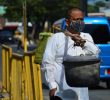Turned into a stable for horses by the Japanese during the wartime, the San Pedro Cathedral also saw through two bombings that rocked Davao in the ’80s and the ’90s.
By CHERYLL D. FIEL
Davao Today
DAVAO CITY, Philippines — Churches they say are not just places of worship, but of pilgrimage and even social gatherings.
Davao City has many churches, but there is only one Cathedral that is the seat of the Bishop, the highest authority of the clergy in a diocese; and therefore this Cathedral is usually made as grand and beautiful.
While cathedrals usually have the grand look of ancient times, the San Pedro Cathedral in Davao City looks austere and yet so different that it stands out from perhaps all the other Cathedrals in the country.
From the outside, it looks like a bow of a Vinta, (a traditional boat made by the Badjao Moro tribe in Southern Mindanao) sailing over waters with a Cross in the middle as the rudder, a departure from the usual façade of Catholic churches.
Sometimes, it looks like the traditional tubao (a scarf used as head garment) worn by the lumads (indigenous peoples) on their heads.
Said to be built in 1847, at the time of Davao’s conquest by Spanish Don Jose Uyanguren who grabbed the land from its first settlers the Moro people of Davao led by Datu Bago, the present look of San Pedro Cathedral is a departure from the original Gothic look of churches in the ancient times.
Some interpreted the present look of the Cathedral to be a symbol of the convergence of the Christians, Moro and Lumad inhabitants who shaped the city’s identity throughout its history.
But this was not how the Cathedral looked before, said Floren Baltazar, who practically lived more than has life around the Cathedral selling religious items at the church grounds in his small stall.
Baltazar, who is now 71, said the original structure of the Cathedral seemingly took a Gothic architecture, with two bell towers standing symmetrical to each other and the main entrance is in between them.
According to Baltazar, the old structure looked like the altar of the church. The altar is still the original one and has been unchanged.
Baltazar said he used to be a sacristan of the Cathedral in his younger days, when masses were still said in Latin and the priest celebrated it with his back turned from the churchgoers.
He said the Cathedral was turned into a “kwadra” (stable) for the horses of the Japanese during the war years in the 1940s.
In the 1960s, the Cathedral was rebuilt by Manuel Chiew, an engineer in Davao, where Baltazar was even one among the workers.
Baltazar said Chiew took inspiration from one of Christ’s disciples, St. Peter, from whom the church took its name. As Peter was a fisherman who took to task Jesus’ commandment to pasture his flock and become “fishers of men,” hence the boat-like figure.
The church edifice must be strong, because as Baltazar said, it had withstood two bombing incidents.
Baltazar recalled the first bombing in April 1981, during a mass on an Easter Sunday. “I can’t say how many died, but I remember that it took five fire trucks to clean up the blood, in the aftermath of the incident,” he tolddavaotoday.com in an interview.
Looking at the shoes strewn around, Baltazar added that he could probably make out 2,000 pairs.
A newspaper account cited that the 1981 blast killed 17 and injured 150.
The second bombing incident at the Cathedral happened in 1993, during a mass in December. Baltazar said the incident killed his fellow vendor.
A report in the Manila Standard Today newspaper, dated 28 December 1993 cited that the blast killed seven people and injured 151 others, 32 of them seriously.
Three bombs were said to have exploded in the incident, the first at the center aisle, followed by another explosion near the altar and another one, at the main entrance fronting San Pedro Street.
The newspaper further cited police and military saying a “Muslim terrorist group” is behind the incident, but no other reports of the investigation came after.
According to Baltazar, almost everything in the San Pedro Cathedral now has been changed, except for the altar, a remnant of a Castilian past.
Baltazar said the altar was transferred to the right wing of the cathedral where relics of St. Peter and other saints were deposed but it was eventually brought back to its original place.
At present, the Gothic designed altar is an imposing presence once inside the cathedral so that one could not miss the sense of being transported back to the era of the past.
Indeed, San Pedro Cathedral, the oldest Church in Davao City, is a historical landmark. Its presence bears silent witness to what was Davao then and now. (Cheryll D. Fiel/davaotoday.com)










